Physical Address
304 North Cardinal St.
Dorchester Center, MA 02124
Physical Address
304 North Cardinal St.
Dorchester Center, MA 02124
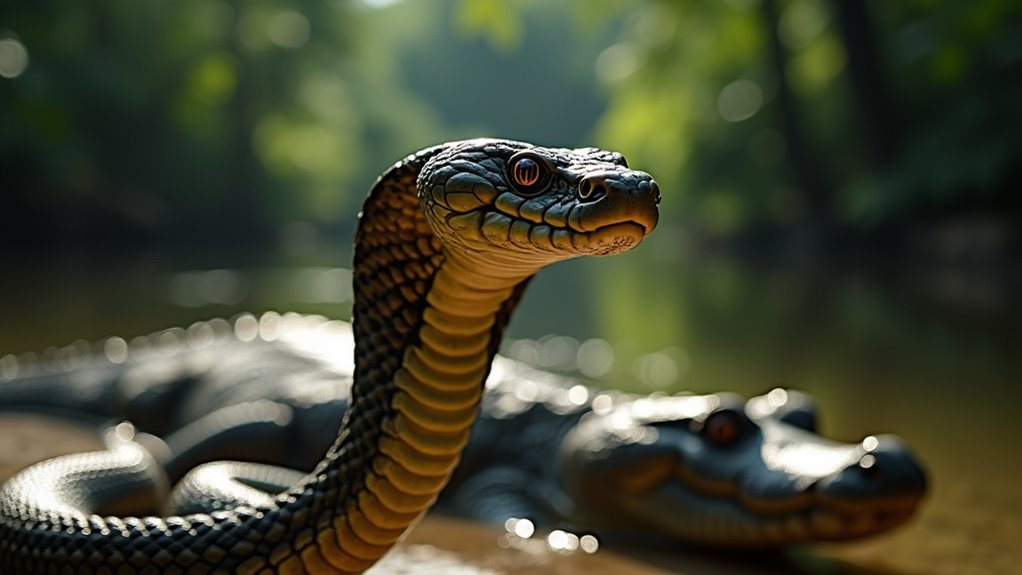
Jungles and seas of Malaysia harbor nine lethal creatures that could turn your dream vacation into a nightmare.
Malaysia’s most dangerous animals include saltwater crocodiles with crushing bite force, lethal king cobras, hemotoxic Malayan pit vipers, and critically endangered Malayan tigers. You’ll also face risks from aggressive macaques, disease-carrying mosquitoes, deadly box jellyfish in coastal waters, painful hornet swarms, and territorial wild boars. Whether you’re hiking rainforests or relaxing on beaches, understanding these creatures’ behaviors and habitats is your best protection against potentially life-threatening encounters.
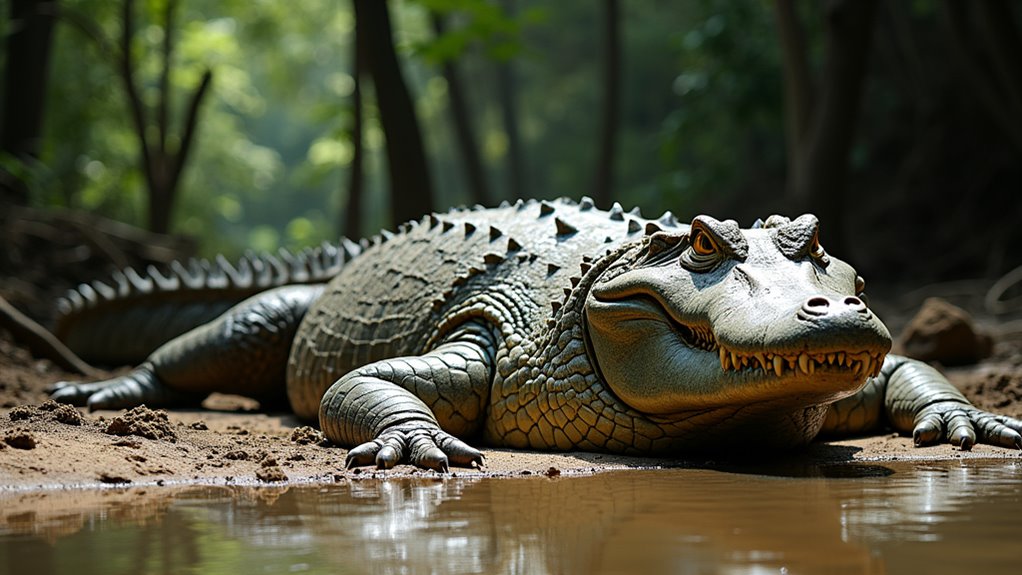
While exploring Malaysia’s diverse wildlife, you’d want to pay special attention to the saltwater crocodile – the country’s largest and most formidable apex predator. These massive reptiles can reach lengths of 7 meters and weigh over 1,000 kg, possessing the strongest bite force of any animal. Their scientific name Crocodylus porosus identifies this ancient species first described by Schneider in 1801.
In Malaysia, they’re primarily found in coastal areas, mangrove swamps, and rivers, with significant populations in Sabah where sightings and attacks have increased. They’re excellent swimmers capable of traveling long distances in both fresh and saltwater environments. Tourists drawn to Malaysia for its rich cuisine often underestimate the threats posed by local wildlife when venturing into natural habitats.
These opportunistic hunters use stealthy ambush techniques to catch prey ranging from fish to mammals. They’re protected under Malaysian law due to their threatened status in Peninsular Malaysia, though they remain dangerous to humans who venture too close to their habitats.
As you venture deeper into Malaysia’s lush landscapes, you’ll encounter the king cobra—Southeast Asia’s most iconic and formidable serpent. These magnificent predators inhabit diverse environments across both Peninsular and East Malaysia, from dense highland forests to mangrove marshlands.
Growing up to 5 meters long, they’re the world’s longest venomous snake with potentially fatal neurotoxic venom. While their potent venom consists primarily of three-finger toxins and snake venom metalloproteinases that can cause paralysis and respiratory failure, you’ll recognize them by their distinctive hood display when threatened.
King cobras primarily hunt other snakes, using their exceptional sensory capabilities to track prey through thick vegetation. If you spot one, remember to keep your distance and use basic phrases that can help you alert others nearby about potential danger.
They’re remarkably adaptable, living at elevations up to 2,000 meters.
While habitat loss threatens their populations, these royal serpents play a vital role in maintaining ecological balance throughout Malaysia’s diverse ecosystems.
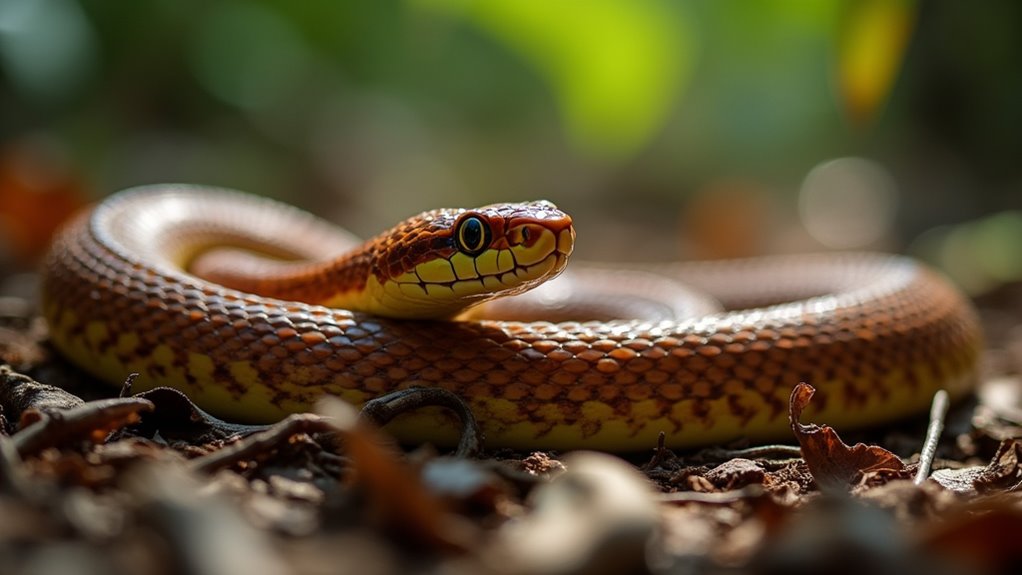
The Malayan Pit Viper may not command the same imposing presence as the king cobra, but what this snake lacks in size, it more than compensates for in danger. Typically reaching about 76 cm in length, this reddish-brown serpent with triangular markings blends perfectly into forest floors and plantations across Malaysia.
Don’t be fooled by its modest size—the Malayan Pit Viper packs lethal venom beneath its perfectly camouflaged, triangular-marked exterior.
You’ll want to be especially vigilant when hiking at dusk or dawn, as these vipers are most active during these hours. Their hemotoxic venom requires immediate medical attention if you’re bitten. With approximately 700 snakebite incidents annually in northern Malaysia alone, this species poses a significant public health concern. Malaysia is home to several other venomous snake species that require similar caution when exploring natural areas.
What makes these snakes particularly treacherous:
Critically endangered across Malaysia’s forests, Malayan tigers remain a formidable apex predator you should never underestimate. These massive cats can reach 2.4 meters in length and weigh 120 kg, making them deadly despite their declining numbers.
When hiking in southern peninsular Malaysia, remember these tigers are excellent swimmers with webbed paws and hunt primarily at night with their light-sensitive eyes. They can consume up to 88 pounds of meat in a single feeding, though they typically eat just once weekly. Their diet mainly consists of sambar deer, barking deer, wild boar, and occasionally bears.
If you’re exploring protected areas like national parks, stay alert—these tigers stalk their prey before attacking with short, powerful bursts of speed. While human encounters are rare, giving these magnificent but dangerous creatures a wide berth is essential for your safety. Similar to popular Vietnamese wildlife reserves, Malaysian conservation areas offer both natural beauty and potential dangers.

Unlike the elusive tigers of Malaysia’s forests, you’ll frequently encounter macaques in urban environments throughout the country. These adaptable primates have increasingly moved into human settlements as their natural habitats disappear due to deforestation and development.
While they might seem cute, macaques can pose significant threats:
Scientific studies have found they primarily target cultivated crops like fruit trees and root crops when foraging near human settlements.
Many residents move to budget-friendly neighborhoods in areas with fewer macaque populations to avoid these daily wildlife encounters.
When encountering macaques, maintain distance and never feed them—this only encourages problematic behaviors and further disrupts their natural ecological role.
While Malaysia’s jungles house formidable predators like tigers and macaques, the country’s deadliest animal is deceptively tiny. Mosquitoes transmit diseases that kill hundreds annually, with dengue being the primary threat.
Malaysia recorded over 600,000 dengue cases between 2015-2021, causing more than 1,200 deaths. You’ll face highest risks in urban areas like Selangor (53.2% of nationwide cases), Kuala Lumpur, and Johor. Recent studies around Chini Lake in Peninsular Malaysia show mosquito diversity and abundance are significantly influenced by disturbance gradients, with highly disturbed areas often supporting more disease vectors.
The Aedes aegypti and Aedes albopictus mosquitoes are the main culprits, transmitting multiple dengue serotypes that can cause severe hemorrhagic fever, especially during secondary infections. Unlike the Philippines with its rich food culture, Malaysia faces significant public health challenges from these disease-carrying insects.
When visiting Malaysia, use repellents, wear long sleeves, and avoid outdoor activities during dawn and dusk.
Eliminate standing water sources around your accommodation to reduce breeding sites.
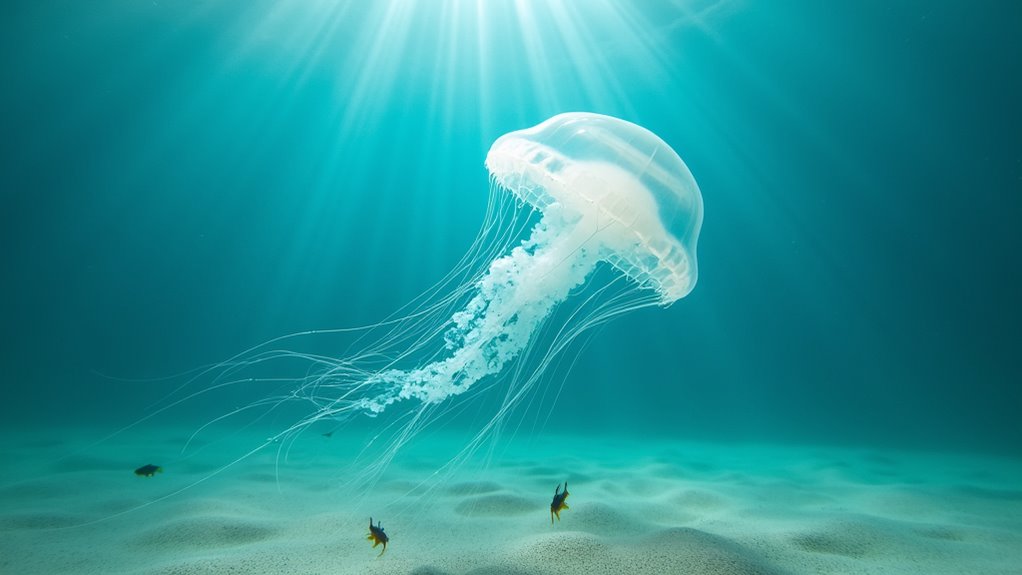
Beyond the disease-carrying mosquitoes, Malaysia’s coastal waters harbor another deadly threat that you should take seriously. Box jellyfish, particularly in Peninsular Malaysia and Sabah, have caused tourist fatalities and numerous severe envenomations. While Singapore has fewer reported cases, travelers should be aware that dangerous marine creatures can be found throughout Southeast Asian waters.
While mosquitoes lurk on land, Malaysia’s waters conceal the silent, deadly menace of box jellyfish.
When swimming in Malaysian waters, remember these vital facts:
Medical facilities often lack specific antivenom, making prevention essential. Don’t underestimate these transparent killers—their sting can be fatal within minutes. The study identified three tourist fatalities from box jellyfish envenomation over a decade, highlighting the real but underreported danger.
From the deadly waters to Malaysia’s lush forests, another formidable threat awaits the unwary traveler. Malaysia hosts several hornet species including Vespa affinis, V. tropica, and V. velutina, active year-round unlike their temperate counterparts.
You’ll recognize these aerial predators by their robust bodies featuring black with yellow or orange markings and smoky brown wings. V. tropica, the largest Malaysian species, is distinguished by its orange second gaster segment. Unlike the bustling urban landscapes of Seoul and Busan, Malaysia’s forests provide perfect nesting grounds for these dangerous insects.
While generally less aggressive than other wasps, don’t be fooled—hornets will defend their colonies if threatened. Their painful stings can cause severe reactions, especially with multiple attacks. These hornets possess powerful stings at the tips of their abdomens primarily used for defense and paralyzing prey in Malaysian ecosystems.
If you spot nests (which can house thousands) in forests or even urban areas, keep your distance. These predators primarily target insects but won’t hesitate to attack humans when provoked.
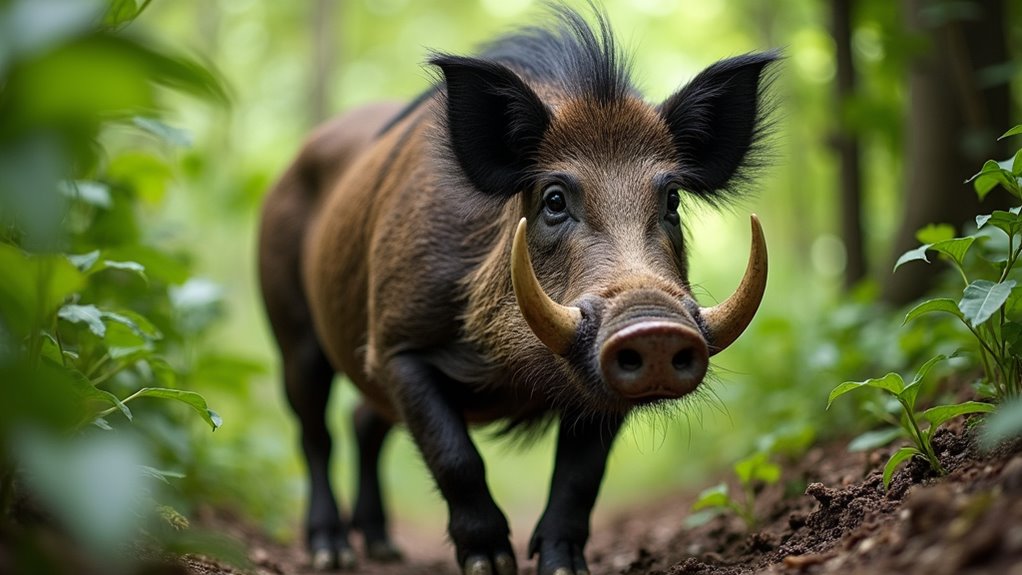
Many travelers visiting Malaysia’s forests keep their eyes on the trees for hornets or scan the undergrowth for snakes, yet they often overlook one of the most dangerous mammals in the Malaysian wilderness: the wild boar.
These forest dwellers, with populations reaching up to 47 individuals per square kilometer before the African Swine Fever outbreak, pose significant risks you shouldn’t underestimate:
Malaysian wild boars possess impressive swimming abilities, allowing them to navigate across bodies of water with ease. While they’re typically less aggressive than Korean wild boars, they should still be treated with extreme caution.
While exploring Malaysia’s woodland areas, maintain awareness of wild boars and their potential danger, especially when they’re protecting young.
You’ve now met Malaysia’s most dangerous creatures, but don’t let fear keep you away. Their beauty far outweighs their threat if you’re prepared. Remember: maintain your distance, watch where you step, protect against mosquitoes, and heed local warnings. Malaysia’s wildlife creates unforgettable encounters—just make sure they’re the kind you’ll want to remember. The wilderness awaits, but it demands your respect.